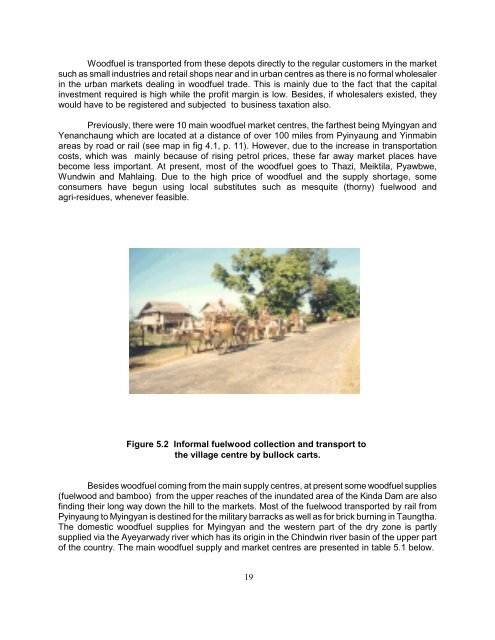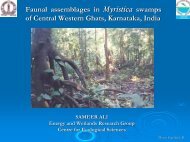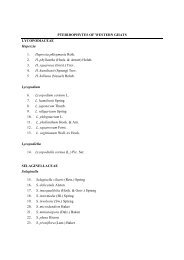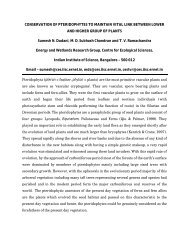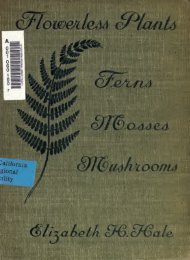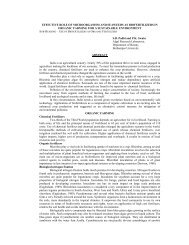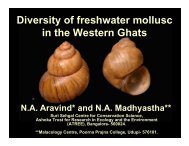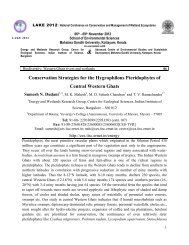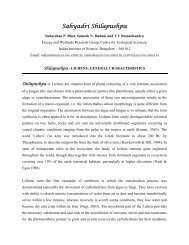regional wood energy development programme in asia ... - CES (IISc)
regional wood energy development programme in asia ... - CES (IISc)
regional wood energy development programme in asia ... - CES (IISc)
Create successful ePaper yourself
Turn your PDF publications into a flip-book with our unique Google optimized e-Paper software.
Woodfuel is transported from these depots directly to the regular customers <strong>in</strong> the market<br />
such as small <strong>in</strong>dustries and retail shops near and <strong>in</strong> urban centres as there is no formal wholesaler<br />
<strong>in</strong> the urban markets deal<strong>in</strong>g <strong>in</strong> <strong>wood</strong>fuel trade. This is ma<strong>in</strong>ly due to the fact that the capital<br />
<strong>in</strong>vestment required is high while the profit marg<strong>in</strong> is low. Besides, if wholesalers existed, they<br />
would have to be registered and subjected to bus<strong>in</strong>ess taxation also.<br />
Previously, there were 10 ma<strong>in</strong> <strong>wood</strong>fuel market centres, the farthest be<strong>in</strong>g My<strong>in</strong>gyan and<br />
Yenanchaung which are located at a distance of over 100 miles from Py<strong>in</strong>yaung and Y<strong>in</strong>mab<strong>in</strong><br />
areas by road or rail (see map <strong>in</strong> fig 4.1, p. 11). However, due to the <strong>in</strong>crease <strong>in</strong> transportation<br />
costs, which was ma<strong>in</strong>ly because of ris<strong>in</strong>g petrol prices, these far away market places have<br />
become less important. At present, most of the <strong>wood</strong>fuel goes to Thazi, Meiktila, Pyawbwe,<br />
Wundw<strong>in</strong> and Mahla<strong>in</strong>g. Due to the high price of <strong>wood</strong>fuel and the supply shortage, some<br />
consumers have begun us<strong>in</strong>g local substitutes such as mesquite (thorny) fuel<strong>wood</strong> and<br />
agri-residues, whenever feasible.<br />
Figure 5.2 Informal fuel<strong>wood</strong> collection and transport to<br />
the village centre by bullock carts.<br />
Besides <strong>wood</strong>fuel com<strong>in</strong>g from the ma<strong>in</strong> supply centres, at present some <strong>wood</strong>fuel supplies<br />
(fuel<strong>wood</strong> and bamboo) from the upper reaches of the <strong>in</strong>undated area of the K<strong>in</strong>da Dam are also<br />
f<strong>in</strong>d<strong>in</strong>g their long way down the hill to the markets. Most of the fuel<strong>wood</strong> transported by rail from<br />
Py<strong>in</strong>yaung to My<strong>in</strong>gyan is dest<strong>in</strong>ed for the military barracks as well as for brick burn<strong>in</strong>g <strong>in</strong> Taungtha.<br />
The domestic <strong>wood</strong>fuel supplies for My<strong>in</strong>gyan and the western part of the dry zone is partly<br />
supplied via the Ayeyarwady river which has its orig<strong>in</strong> <strong>in</strong> the Ch<strong>in</strong>dw<strong>in</strong> river bas<strong>in</strong> of the upper part<br />
of the country. The ma<strong>in</strong> <strong>wood</strong>fuel supply and market centres are presented <strong>in</strong> table 5.1 below.<br />
19


